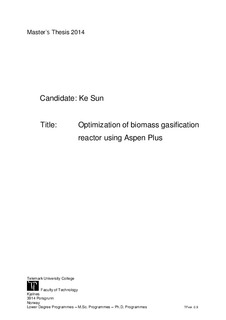| dc.description.abstract | Biomass is an ideal renewable and clean energy resource. Counties all over the world are paying more and more attention to biomass because it can effectively reduce greenhouse effect due to its zero carbon dioxide emission. Among the biomass utilization technologies, biomass gasification for combined heat and power is an attractive solution for utilizing biomass effectively. The biomass gasification was studied based on the dual fluidized-bed gasifier developed by the Vienna University of Technology, which has been successfully demonstrated in Güssing, Austria. Aspen Plus V8 was used for the modelling and simulation of the biomass gasification process. The gasifier was modeled using minimum Gibbs free energy method. The key operating parameters including the feed steam temperature, feed air temperature, steam to biomass ratio, and the gasification temperature were varied using the sensitivity analysis block of Aspen Plus. The effects of changing the parameters on the output syngas composition, LHV of the syngas, char split fraction and the gasification efficiency were studied. The sensitivity analysis results indicated that both preheating the feed steam and air have positive effect on increasing the LHV of the syngas and the gasification efficiency. Preheating air is more effectively than preheating the steam. Increasing the steam to biomass ratio results in the increase of the hydrogen yield and the proportion of hydrogen content in the syngas, while the increase of the S/B had negative effects on increasing the LHV of the syngas and the gasification efficiency. Increasing the gasification temperature resulted in the decrease of the gasification efficiency and the hydrogen yield, while it had positive effect on the increase of the LHV of the syngas. The gasification results behaved a little different when the steam to biomass ratio and the gasification temperature are low. Base on the results, it was found that the optimum gasification temperature should be kept around 750-850 ℃, the steam to biomass ratio should be kept around 0.4-0.6. If excess heat is available it should be used to preheat the feed air. | |
